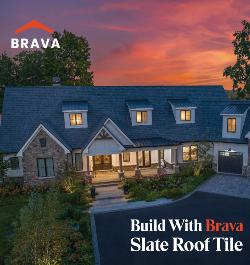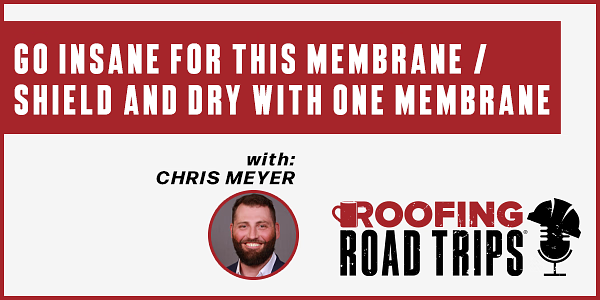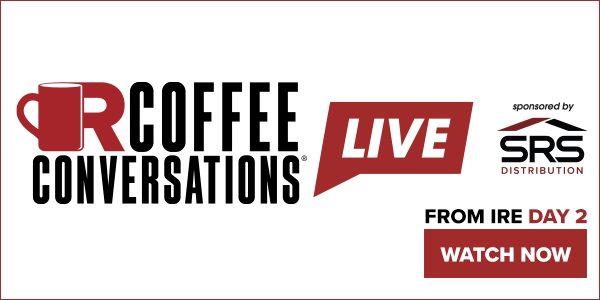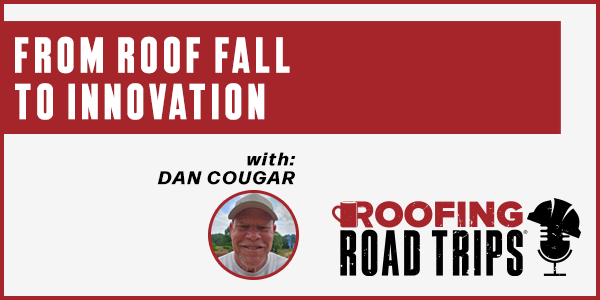Shield and Dry with one Membrane - PODCAST TRANSCRIPT
July 3, 2024 at 12:00 p.m.Editor's note: The following is the transcript of a live interview with Chris Meyer from VaproShield. You can read the interview below or listen to the podcast.
Intro: Welcome to Roofing Road Trips, the podcast that takes you on a thrilling journey across the world of roofing. From fascinating interviews with roofing experts to on-the-road adventures, we'll uncover the stories, innovations and challenges that shape the rooftops over our heads. So, fasten your seat belts and join us as we embark on this exciting roofing road trip.
Heidi J. Ellsworth: Hello and welcome to Roofing Road Trips from RoofersCoffeeShop. My name is Heidi Ellsworth, and one of the things that I'm so proud about on our Roofing Road trips is when we get to bring new products, new ideas, things that are going to revolutionize and change the industry to all of you listening. And today is no different, it is actually very exciting. My friend Chris Meyer from VaproShield is here today to talk about serious revolution for the roofing industry. Chris, welcome.
Chris Meyer: Thank you for having me, Heidi. Glad to be on.
Heidi J. Ellsworth: I am so excited for you to share what you have going. We've worked together off and on a lot over the years, and this is really cool stuff. So, let's start first with an introduction. If you can introduce yourself and tell us a little bit about your company.
Chris Meyer: Yeah. So, my name is Chris Meyer. I am the director of low-slope roofing at VaproShield. I lead our efforts in the commercial roofing business, overseeing strategic direction and execution for the segment. VaproShield has actually been in business for over 20 years. Started off in the wall water-resistant barriers business. Has been in the steep slope business now for a few years as far as steep slope underlayments. And now obviously we are entering into the commercial roofing market, leveraging that 20-plus years of product DNA to make sure that our products are fit for purpose and high performance.
Heidi J. Ellsworth: I have watched VaproShield over the years, the Frog. I have to tell you such great things and to know that you're bringing that technology to the roof is super exciting. So, let's just start there, Chris. Let's tell us why VaproShield looked at this and said, 'Hey, we need to go to the roof.' Why are you launching that? And give us that bigger picture.
Chris Meyer: So, the phrase that we're using is, "the roof is walking from the wall to the roof." similar to how this company started, it's really looking at some of the unmet needs in the market. And there are a lot of unmet needs around air tightness, moisture management, energy efficiency. And then you throw in the wrench in there of the increasing stringency of building codes and energy codes and it all just becomes even more complex. So, there seems to be a void within the industry, whether it's pain points around moisture and concrete, whether it's pain points around condensation and roofing systems. We're seeing a lot of damage to wood decks out west. A lot of these all come down to air tightness and controlling air movement and moisture management within the roofing envelope, which ... That's really what we're here to help solve.
Heidi J. Ellsworth: Yeah. Yeah, it is. It is all about understanding that. So, how do you see your products going from the walls to the roof. And how is it working within those systems? Give us that vision of how it's going to work, the air barrier, the whole nine yards.
Chris Meyer: Yeah. So, it is a slight transition, obviously different horses for different courses. So, we do have different products that are used in the commercial roofing space. But, there are similar needs when you look at a building. And within commercial roofing, we've always focused on constricting moisture movement and constricting ... Dealing with UV, dealing with a lot of the elements. And we haven't focused a ton on the building science part of things. And with the increasing energy codes around air tightness. Now this is becoming a deal that people are paying attention to. And so, I think the main transition is going to be a water-resistant barrier is expected to hold out moisture and it's going to be somewhat exposed to the elements.
Chris Meyer: These products, they shouldn't be exposed to the elements if they're installed correctly, since we're going underneath waterproofing systems in some cases. But the main transition is really going to be taking that permeable vapor retarder technology from the wall to the roof. Historically, roofs either use a few layers of [inaudible 00:05:08] as an air barrier or they'll use a traditional vapor barrier, which would obviously be a moisture barrier, plus have air tightness qualities to it as well. But, roughly 70% of the market right now, there is no continuous air barrier within the roof system, which the data indicates that's causing a lot of these problems that are causing these unmet needs in the market.
Heidi J. Ellsworth: Yeah. So, talk about that water movement and how Slope Shield really works with letting it move and get out and permeable, all of that. Talk about how that works.
Chris Meyer: Yeah. So, to put it in context, we'll back up a second to if you look at an air barriers, whether you want to call it an air barrier ... They all have different vapor retarding characteristics. And right now the classes one through three don't really account for a product like Slope Shield. And the idea that anything over 10 perms is just vapor open is quite frankly a little misleading, because the data does indicate that those products on the lower end of that spectrum still do offer a degree of moisture control. So, where this product really comes in is roughly 90% of condensation and moisture issues in a roofing envelope are due to air movement.
Chris Meyer: So, through its air-barrier characteristics, it cuts down on the majority of your problem from the get-go. But then, where it differs from traditional products is that it is vapor permeable, even though it still offers a degree of moisture control at 30 perms. So, it will allow the roof to seek equilibrium through the seasonal cycles, allowing moisture vapor somewhat to get into the system, not to a point where it would condense, versus traditional systems right now, which based on a lot of industry data, not having a dedicated air barrier or using ISO, you're still letting upwards of seven gallons of moisture into your roof system on an annual basis just through air movement.
Heidi J. Ellsworth: Wow! Wow! Talk to me just a little bit about re-roof, new construction, where Slope Shield really as a contractor out there right now, when should they use it? All the time? What systems make the most sense? And I want to talk just a little bit too about new construction with concrete and such and then also re-roof.
Chris Meyer: Yeah. So, this product really does offer innovations for contractors and for other customers, mainly in its versatility. If you look at your traditional vapor barrier products like our Block Shield product, they do definitely have their uses different horses for different courses. So, in any of your high-humidity buildings, pools, things of that nature or your typical design zones of Ash Ray seven and eight, that's typically where you're going to want to use a true vapor barrier. This product, however, on new construction and re-roof has a much wider applicability, simply because of its vapor permeance. Typically we're seeing that it could be used anywhere from Zone One through Zone Six to really control that air movement and offer a degree of moisture control. So, that's a main use for it there on new construction re-roof.
Chris Meyer: But, new construction used for this product would be on structural concrete or lightweight concrete. Because it is vapor permeable, you can actually put this product down five days after pour, just enough to get a little bit of a film there for us to stick to. You can put this down after five days and it creates a controlled environment for your concrete to dry out, so that no new moisture is introduced. Then you can roof right over the top of that. So, that's obviously a very valuable benefit. And then, obviously, once you roof over the top of it just transitions into an air barrier and permeable vapor retarder. So, you're getting a dual function there. And then, finally, the other use for this is in re-roof and recover.
Chris Meyer: We have an active project right now that was a pain point for the customer for years, going on something like five years. And existing roof, concrete deck, a few layers of EPS, old Hypalon roof and some silicone coating on it. And we actually came in, poked holes in the roof, put our stuff down in some of the areas where it got really thick. We did put some two-way vents for some added air movement. But, within 47 days, that roof was, from inspection, from the inspector's choice of words was "bone dry."
Heidi J. Ellsworth: Wow!
Chris Meyer: And this was a roof that had been retaining moisture. When we cut some of the cores open, you could visibly see water in the roof. So, now they're going to go over that with a finished roof system. And at least according to the customer, it's saving them about $250,000. So, that's a win for me if I've ever seen one.
Heidi J. Ellsworth: Yeah. That is huge. Chris, when you think about what is happening out there right now in the market with the restoration, it is such a hot trend, I should say. It's probably a bad use of words. But, when you think about how much is going out there when they're coming in and they're trying to dry out these roofs, they're trying to figure out can they coat it again? Do they have to tear it off? Do they have to re-roof? You are offering just a whole new way of looking at it, a whole new way of thinking about it that could really change the game for a lot of contractors and building owners.
Chris Meyer: Yeah. This definitely is challenging the existing paradigm. As of right now, if you have a roof that has some issues, the common thing is, if 25% of your roof is wet, it's time to tear the whole thing off and start over. But, obviously, you have some coatings and they'll give you 10 to 15 years. But, this solution solves more than one issue. One, it allows you to save all of those existing components. You can install a new roof system over the top, which you're cutting your costs for an entirely new roof system that you'll probably get 20, 30 years out of. And on top of that, now your roof system has a dedicated air barrier within it that is also vapor permeable, so you're cutting down on the moisture that's getting into your roof system. You're also allowing your roof system to dry out if there is any moisture that does happen to get into it. And then on top of that, you're cutting down your heating and cooling costs, because of all of this energy efficiency that you've now added into your roof system design.
Heidi J. Ellsworth: Yeah. Wow! That is so cool. So, you also have Slope Shield Plus, self-adhered membrane.
Chris Meyer: Yes.
Heidi J. Ellsworth: Talk about that a little bit.
Chris Meyer: Yeah. So, the Slope Shield Plus is our air barrier and permeable vapor retarder product. This is the one that is challenging existing paradigms around moisture control, because it is a solution that provides optimal moisture control and air leakage protection. But, it also simultaneously allows the building envelope to breathe or dry out throughout the seasonal cycles.
Heidi J. Ellsworth: And that's all self-adhered. So, that's why when you were talking about the concrete ... Sorry. I'm catching up here. But, that's why you were talking about the concrete, you needed just enough so you can apply it.
Chris Meyer: Absolutely. And the product's adhesion to concrete is phenomenal. Both products are Slope Shield Plus, as well as our Block Shield, SA-plus, vapor barrier and permeable vapor retarder. Both products achieved a 495 PSF direct to concrete with no primer, which for anyone who's not overly familiar with those tests, that is the maximum uplift that you can get over concrete.
Heidi J. Ellsworth: Wow! Wow! So, okay. As contractors are looking at bringing this new product in, since it is a new product, talk to us about where you're at with testing and specifications. How can contractors just really start using this and adding it to current systems or as we talked about restorations?
Chris Meyer: Yeah. So, obviously we're in the early phases here. But, right now we do have an updated FPC report or Florida Product Approval report, however you want to designate it. That should be published here in the next two weeks. That will be non-high velocity as well as high velocity. We currently have a few ROOFNAV listings for mechanically attached systems and some UL E108 fires or 790, since it's UL. But, other than that, we're rounding out with a few programs at FM. Obviously doing a little bit more testing to increase the amount of approval options that we do have for the folks out there.
Heidi J. Ellsworth: Yeah. So, contractors. As they are looking at adding this into their system, they just need to really work with your tech team, because certain how long you have to wait until you re-roof over it, depending on the deck below, the restoration. What are some of the restrictions that they should be aware of?
Chris Meyer: So, I would say that the restrictions to be aware of, I would really lean heavily on obviously our tech team, but also the building code officials or the designer of record, because ultimately the designer of record's going to have the final say. And it will vary depending on ... Obviously one big question we get is, well, how wet is too wet? Well, if the concrete industry is not willing to answer that question, I'm probably not going to put it in writing either.
Chris Meyer: But, when you look at it, I'd say it varies from project to project. So, definitely reach out to our team if you have a candidate that you would like us to take a look at. But, for the most part, we have some case studies online. Like we had a plywood deck project up in Portland that the plywood was roughly 40% moist at the time from the readings that we got. And we took that all the way down to 10% in 43 days. So, that's part of it. And we also do have some extensive long-term R&D projects going on to get more of a solid benchmark over various substrates for what drying time should be expected.
Heidi J. Ellsworth: Wow! So, to that point, with the projects you've done and the contractors who have used it, what are they saying? What's some of the feedback?
Chris Meyer: The feedback thus far has been very, very good. Obviously there's nuances to using some products that are a little bit different. Obviously using thinner products, you can't leave metal shavings and screws sticking three inches out of the deck and go over it. But, other than that, the feedback has been phenomenal as far as the adhesion, the uplift, the way that the product does that, what we say it's going to do, the durability of both products. Up until this point, the only thing we've had tear the Slope Shield product is a scissor lift.
Heidi J. Ellsworth: Wow! Wow! That's awesome. And you and I talked a lot about this while we were at the iBeck Convention. What are you hearing from roofing consultants?
Chris Meyer: From roofing consultants, the feedback has been very, very good. Obviously, I think a lot of this is just trying to hone in on which application you want to use it for, because it is the vapor retarder air barrier of possibilities, because of its versatility. There are a lot of people that are really liking the idea of this dry out and reuse existing components. Whether you're looking at it from a limiting capital investment standpoint, whether you're looking at it from reducing material to landfill standpoint, it's definitely a very sustainable application. But, the other part that a lot of people have had that light-bulb moment with is using air barriers in zones one through six that do have a degree of permeability to them, just so that you do still have that degree of moisture control, making sure you're not getting copious amounts of moisture causing issues in your roof. But, still having that needed air tightness throughout the seasonal cycles, to make sure our buildings are as energy efficient as possible and maintaining good indoor air quality.
Heidi J. Ellsworth: Yeah. Yeah. That is just so huge, as you're talking about that. And the other thing is the ability to dry out the roof. I just think that is something that people have been looking for to try to figure out and is going to just be revolutionary as we began, as we talked about at the beginning. So, how can contractors get this into their hands and start using it within their projects?
Chris Meyer: So, there are several ways that contractors can get this in their hands. It is available nationwide. We do have six strategically located warehouses across the country, as well as some distributor partnerships. Obviously, our website is a very useful resource to help find the local sales representative in your area. Obviously there's also some pages around getting technical assistance, things of that nature. I would always encourage everyone to reach out to our technical team. They're very knowledgeable, highly skilled in what they do. And then obviously, always look to find us on LinkedIn, Facebook and some of the other social media platforms out there.
Heidi J. Ellsworth: And you can find all the information about VaproShield on Roofer's Coffee Shop directory. That will get you to all these resources that Chris is talking about and help you learn more and figure out how this is going to really change your business. I think I want to end just on how important it is for contractors to be able to find these new products, work with people they trust, a company that's been around for 20 years that understands the building envelope. And really then be able to explain that to their building owners on all of the benefits. So Chris, as you are seeing the contractors working with the building owners and bringing this new type of technology in there to use on the roof, what are some of your tips that I would say, tips to the contractors as how they start explaining why this is important?
Chris Meyer: Well, I think the main way to start is looking at the increase in energy codes. We spend quite a lot of dollars per year, whether it's electricity, gas, whatever it is, keeping the lights on, keeping the buildings hot or cold. So, having a dedicated system within your roofing system to help keep those costs down is definitely advantageous. But, it also is just better for the building. Whether we're talking about the integrity and performance of the roof system to fulfill its service life, whether we're talking about indoor air quality and the possibility of mold. But, the big part of this is just the shift in technology. We used to call it the wetting and drying cycles of a roof, back when we had black roofs. Now that we have all these highly reflective options and everything's increasing around the Heat Island index, when you switch to these highly reflective roofs, the temperature of the roof doesn't get as high. So, it doesn't have the ability to dry out the way that it used to. So, we need to look at some newer ways of controlling how moisture is introduced into that system.
Heidi J. Ellsworth: That is perfect. I love that. I love that. Use this everyone out there. This is going to differentiate your business, which is always exciting. And really help you take something very important to your building owners who you're working with. So Chris, thank you so much for being here today.
Chris Meyer: Thank you very much for having me on Heidi. It's always a pleasure.
Heidi J. Ellsworth: I love it. I love it. And I thank you all for listening. Great information for your business. Be sure to share this with other roofing professionals. This is something that's going to really be changing the industry. Be sure to listen to all of our podcasts under the read, listen, watch navigation of RoofersCoffeeShop. Look for Roofing Road Trips, or on your favorite podcast channel. Be sure to subscribe and set those notifications, so you don't miss a single episode. And we will be seeing you next time on Roofing Road Trips.
Outro: If you've enjoyed the ride, don't forget to hit that subscribe button and join us on every roofing adventure. Make sure to visit rooferscoffeeshop.com to learn more. Thanks for tuning in, and we'll catch you on the next Roofing Road Trip.






















Comments
Leave a Reply
Have an account? Login to leave a comment!
Sign In